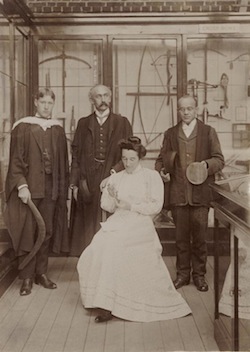 1998.266.3 The first diploma students: Freire-Marecco in front, F.H.S. Knowles to left; J.A. Harley to rightPeter Rivière
1998.266.3 The first diploma students: Freire-Marecco in front, F.H.S. Knowles to left; J.A. Harley to rightPeter Rivière
The Diploma was introduced in 1906 and examinations were first sat in 1908 with papers in physical anthropology, ethnology: archaeology and technology and sociology.
During this period people could read for a Diploma and B.Litt/ B.Sc simultaneously. It was not until the 1940s that the trajectory of Diploma/ B.Litt/ D.Phil became the norm.
For a very large percentage of students the award is unknown. In most cases this was almost certainly because people did not sit the examination. A notable feature of the early history of the Diploma was how many of those admitted failed to receive any award; not, it would appear, from failing the exam but from not presenting themselves for examination.
Anthropological instruction was also provided for colonial administrators. Colonial cadets did not have to enrol and many of those that did, did not get round to sitting the exam. Candidates came from India, the Malay States and East and West Africa.
The first four students were enrolled for the course in Michaelmas Term 1907. The following year this number dropped to two, but then rose steadily; three were admitted in 1909, seven in 1910, thirteen in 1911, sixteen in 1912, and then a huge jump in 1913 to forty. After the First World War the annual intake settled at around 10 students.
The educational backgrounds of the students during this period were very varied. Many of them had first degrees, but many did not (having been employed in the colonial service).
In 1907 the Certificate in Anthropology was introduced. It required a candidate to have been engaged in the study of physical anthropology or of cultural anthropology (ethnology either with archaeology and technology, or with sociology) for a period of three months. The regulations allowed for a candidate to earn a Diploma by an accumulation of all three Certificates over a number of years.
In 1930 a 'research certificate' was introduced to confirm that someone was qualified to carry out anthropological research and it required either a Distinction in the Diploma or a confirmation from the candidate's tutor that the student had reached the required standard.
For most of the period up to 1945 three men were primarily responsible for teaching the Diploma; Henry Balfour, R.R. Marett and Arthur Thomson.
Diploma students did not have to matriculate and thus did not have to be a member of a college. This accounts for those who have no college listed for them or described as not being members of the university in the following information.
The teaching of physical anthropology was located in the Department of Human Anatomy, from 1927 it became known as the Laboratory of Physical Anthropology. The Department of Ethnology, was located in the Pitt Rivers Museum. Social Anthropology had a much more nomadic existence. To begin with, because of the few involved, space was found in Exeter College, but the numbers outgrew that and in 1914, the year in which permission to use the name Department of Social Anthropology was given, its home became Barnett House, 26 Broad Street. From there, in 1920, it joined with the Geographers in Acland House, 40 The Broad, and in 1936, when Acland House was to be demolished to make way for the New Bodleian, it followed the Geographers to 1 Jowett Walk, on the corner of Mansfield Road.
We are very grateful to Peter Riviere, Professor Emeritus of Social Anthropology, University of Oxford and Fellow Emeritus of Linacre College, Oxford, who provided the above information for the Relational Museum project, between 2002-2006



